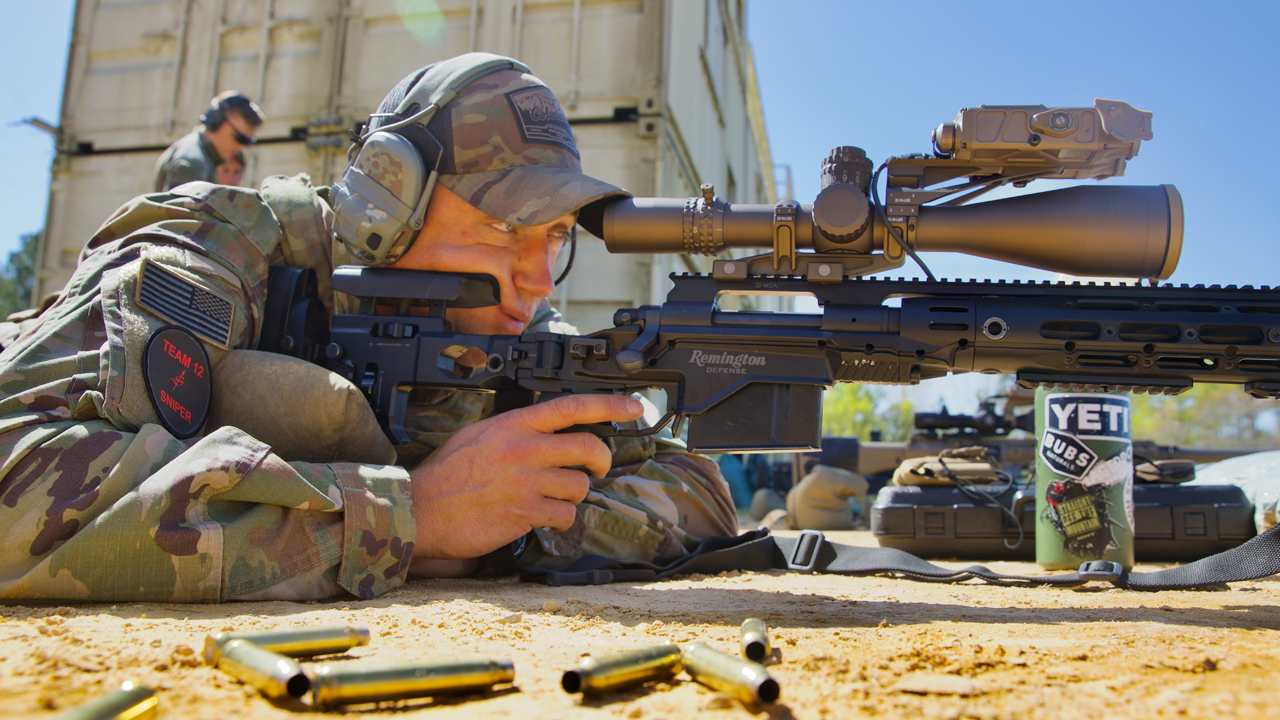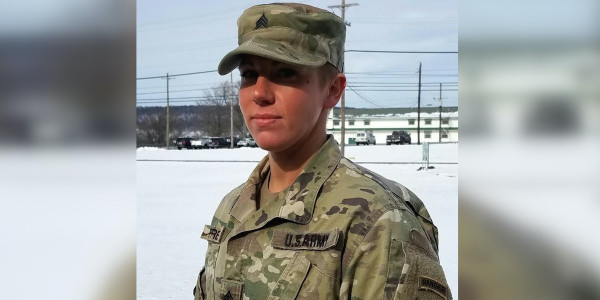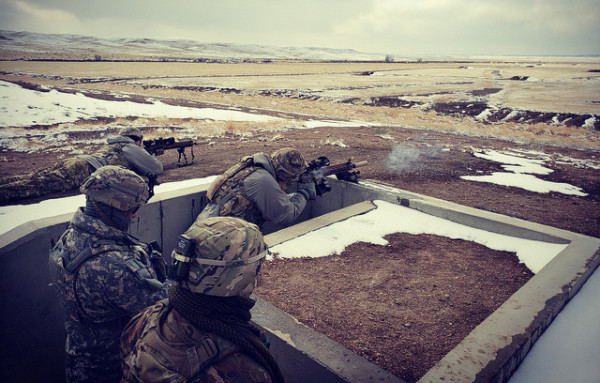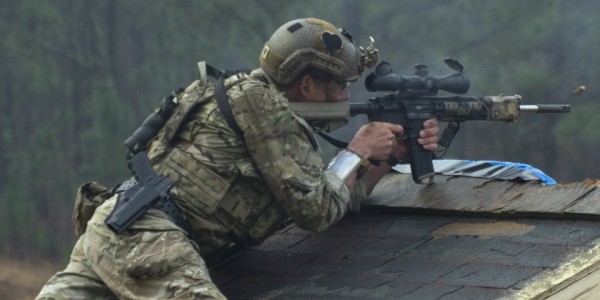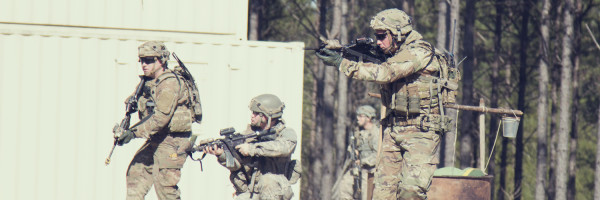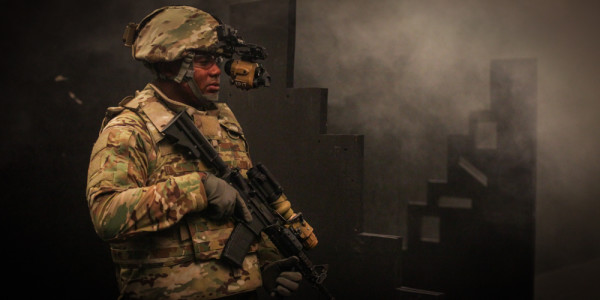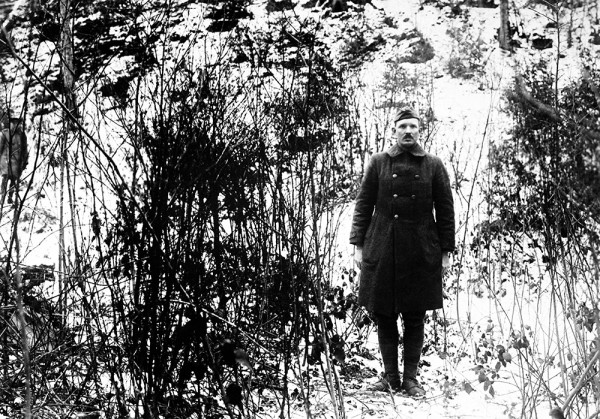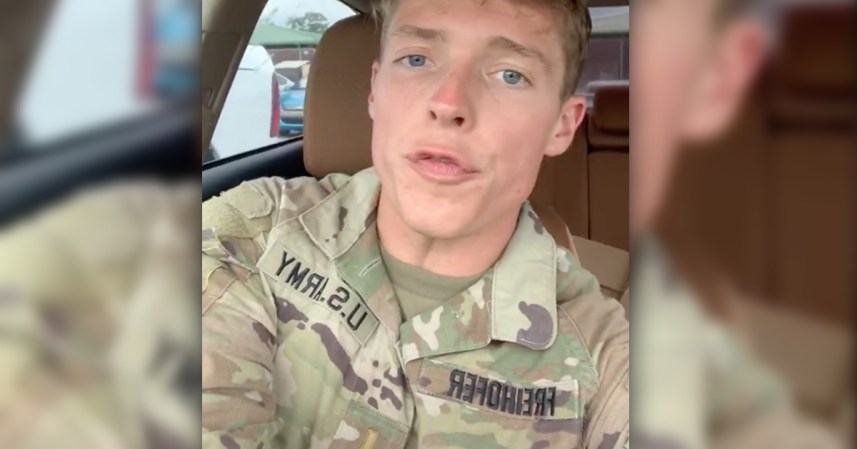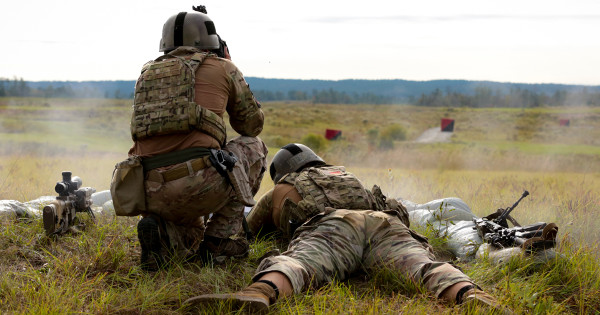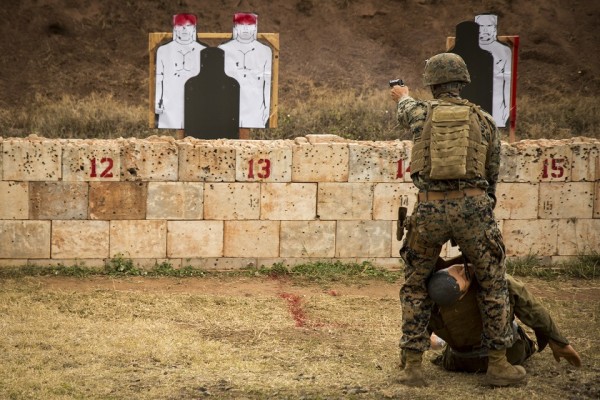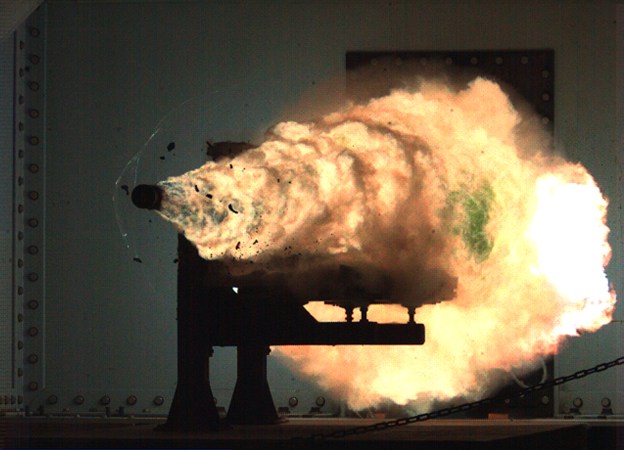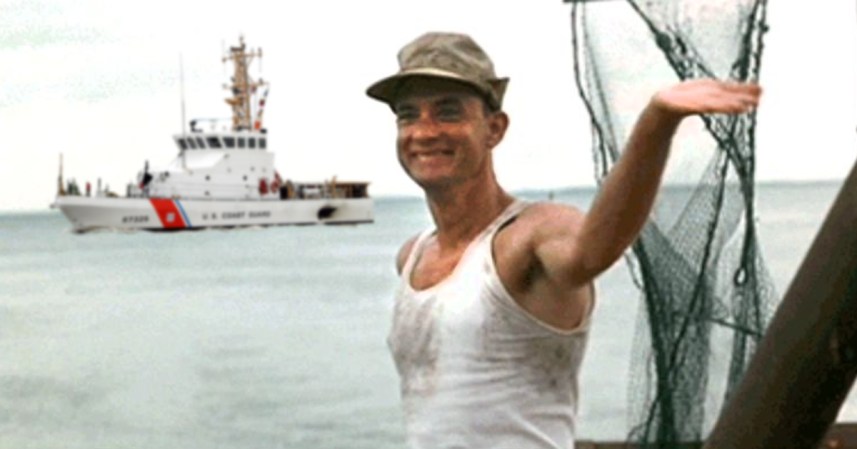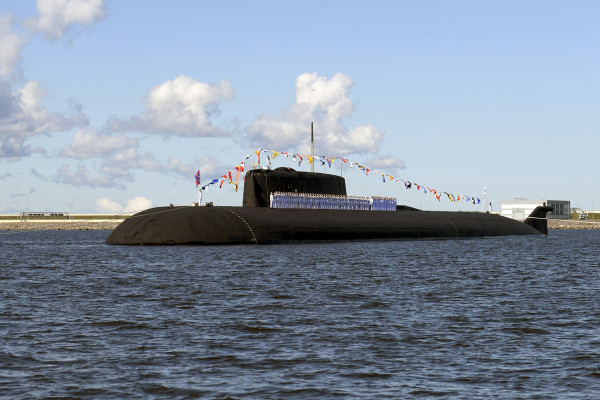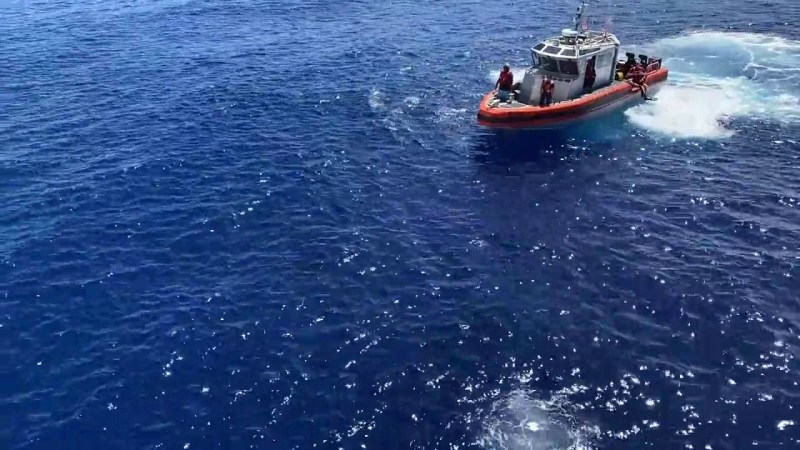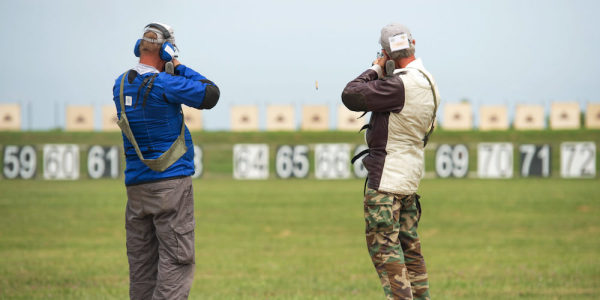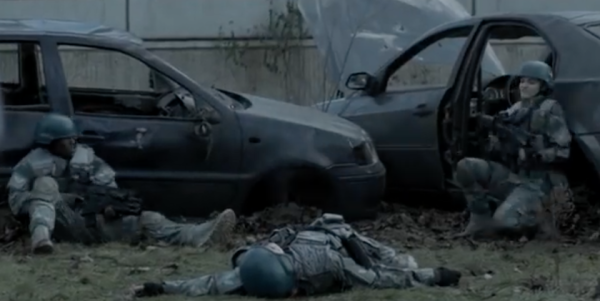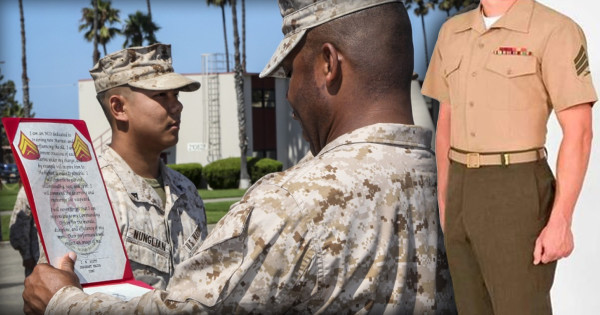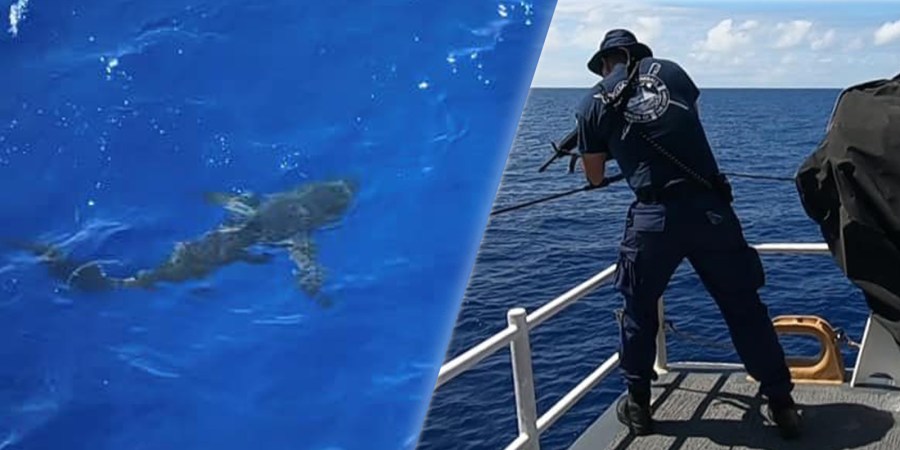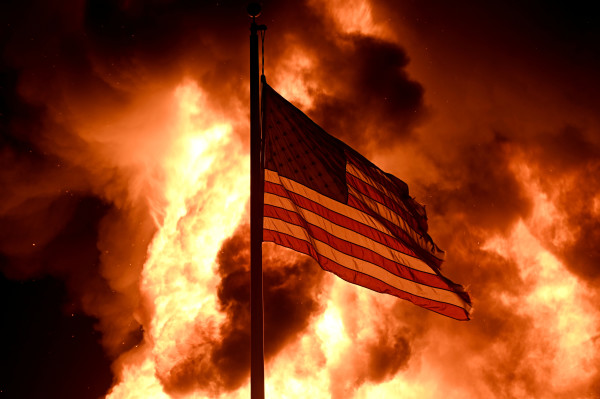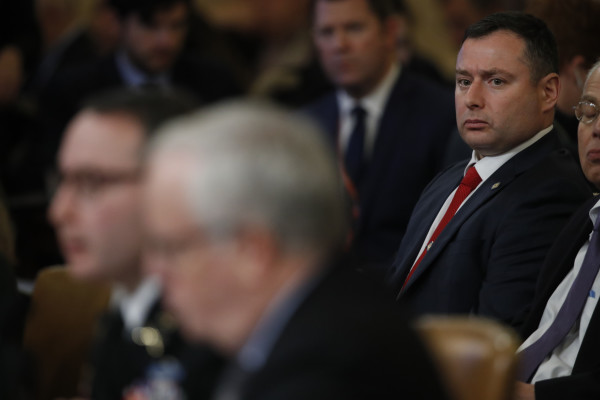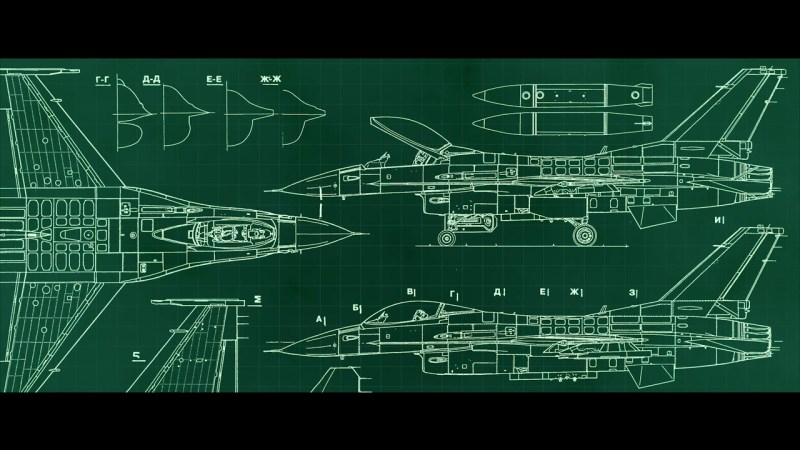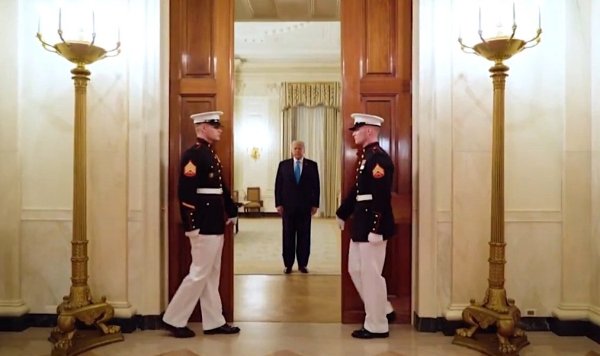The three U.S. Army snipers came running out of an empty building and immediately dropped their gear in dirt still soft from yesterday’s rainstorm. Two of the men, Sgt. 1st Class Greytak and Staff Sgt. Underkofler, slammed onto their bellies, dropping into the prone position, while the third, Sgt. 1st Class Farson, kicked out a tripod and immediately began scanning the field before him.
They were zeroing in on a high-priority enemy target roughly 750 meters away — a general — along with an entourage of his deputy commander, driver and bodyguard. In the distance, the low rumble of thunder mingled with distant sounds of gunfire as the snipers got to know their target.
“Nine o’clock, attack tank. Looks like a general hat,” the spotter said.
“I”ll take him,” one sniper replied.

Subscribe to Task & Purpose Today. Get the latest in military news, entertainment, and gear in your inbox daily.
The trio was literally and figuratively working under the gun with only four minutes — and six rounds — to take out their targets. But that’s plenty of time for a well-trained sniper team. Whereas some may have panicked to hear they only had 47 seconds left before they had to go, these soldiers relished in it, with one commenting that they had “lots of time.”
The general and his posse weren’t stationary, which made it that much harder. So one by one, the team worked through their targets: as the spotter called out that their target in the moment had stopped, the shooter on that target would lean into the trigger. At one point, the spotter and one of the shooters switched, the spotter dropping into the dirt on his gun while the shooter popped up and took his place.
One after another, the crack of each shot echoed across the grassy field before them. With just a second or two left before their window was closed, the final shot rang out. Behind them, a U.S. Army Sniper Course instructor watched his stopwatch. Though this was merely a mock training scenario, the event was part of a deadly serious contest to crown the best sniper team in the world among 30 three-man teams competing at Fort Benning, Georgia.
“Alright gentlemen,” the instructor said at the conclusion of the team’s time. “Lock and clear your weapons.”

The exercise in taking out their targets under a time constraint was the final event of the three-day competition, meant to simulate a combat mission. It started at midnight on April 4 with sniper teams from across the U.S. military and around the globe infiltrating a mock “area of operations” called Flavor Town. From there, they worked through one event after another that tested not only their shooting skills, but communication abilities, stamina, and ability to retain information under stress.
In other words, it tested their very essence as a sniper.
‘I never quit’
Snipers are comfortable being uncomfortable. They have to be “physically fit, patient, even-keeled, quiet, smart, good at math, agile, and adaptive,” a U.S. Sniper Course instructor said in 2017. While they are highly-trained marksmen, they’re also used as intelligence gatherers and must have an extreme attention to detail to provide valuable information for commanders on the ground.

Sniper teams are an “all-weather durable asset” who can outlast technologies like drones that commanders might use to gather intelligence, said Capt. David Wright, the commander of the sniper school. Whereas a drone might run out of batteries, a sniper can look through their scope from a thousand yards away and give commanders feedback like what door of a house the enemy is using, or which windows are or are not boobytrapped. Historically they’ve been used to create “dilemmas for opposing commanders,” Brig. Gen. Larry Burris, commandant of the Army Infantry School, said at the competition’s closing ceremony on April 7.
“The war in Ukraine is a fitting example as last month a Ukrainian sniper killed the first of multiple Russian general officers in conflict at a distance of approximately 1,500 meters,” Burris said.
Snipers are a “special breed of people that come together, that bond in a special way and are very committed to each other,” said retired Command Sgt. Maj. Lonny Wright, a volunteer at the competition who had served as the noncommissioned officer in charge of the sniper course before retiring in 2008. Indeed, the sniper community is incredibly small, as many competitors noted that they were familiar with the competition or figured it was only a matter of time before they ran into each other again soon.
That kind of familiarity didn’t only apply to American competitors, but to international teams as well. While they may do some things differently, snipers are still snipers, and the international competitors appeared to quickly blend in with the rest of the teams.
That’s not to say there weren’t some distinctions, including their obviously different uniforms and uniquely-acceptable facial hair. Some also just had different attitudes. The troops from other militaries were “very knowledgeable,” “very humble,” and “very mild-mannered,” according to one U.S. sniper based near Anchorage, Alaska. That humility was put on display time and time again throughout the competition, starting on the very first day.

When asked if they thought they could win the whole thing, one U.S. soldier smiled smugly and said, “Always.” Asked the same question moments later, a Swedish competitor said, it’s “a little bit early to say.”
Students of the U.S. Army Sniper Course are incredibly passionate, and they have to be, said Staff Sgt. Andrew Dominguez, a sniper instructor. By the time soldiers complete the course, Dominguez said, they will have been vetted for “anywhere from six months to a year and a half.” And similar to other intense training courses, it’s not uncommon for students to try more than once to make it, as was the case for the first woman to graduate the course in November. In fact, a member of the winning team said he had multiple attempts at sniper school before he made it through, and it wasn’t easy.
“I never quit, I kept going, kept training and training and training, raising my hand and saying I want to do this, I want to do this,” Underkofler said. “And to finally get the opportunity to shoot with these two and perform this well is a way to step back and say okay, I checked off that goal.”
That kind of perseverance and grit was demonstrated throughout the competition from every sniper there, who were practically walking and talking personifications of an “embrace the suck” mentality. But that attitude was perhaps no more on display than on the second day of the competition, when snipers weren’t just up against each other, but the elements as well.

By the morning of April 5, the teams had perhaps a few hours of sleep since the competition had begun. As the sun rose at one range, the competitors were laying down in a holding area off to the side and wrapped in layers as they listened to the instruction for their first event. It was purposefully vague; almost every question was answered simply, “you’ll find out on the range.”
The sun had barely risen when thunder could be heard in the distance. And soon, the storm sounded like it was right on top of Fort Benning, opening up into a torrential downpour that only somewhat softened for the rest of the day. Every uniform was soaked and muddy. Boots were caked with dirt. Where the day before there had been streams of sweat running down competitors faces, now it was indistinguishable from rain.
It was an absolutely miserable day. And the snipers loved it. Talking to competitors after each event, while they lugged their gear and guns back to the bus to get a brief respite from the weather, one phrase they said over and over again was: This is so fucking fun. And not only did they find it fun, but they didn’t see it as any different than anything else they were up against.
“That’s part of the competition,” said Staff Sgt. Benjamin Holley, a sniper with the Arkansas National Guard. “You’ve got to be able to deal with whatever weather conditions come at you.”

“I want the rain,” said Underkofler. “I want it to be nasty, I want it to be ugly, because that’s something I know how to handle … It’s just another day on the job. We don’t get to cancel missions in the real world because of nasty weather, so throw your kit on and get out there and run and gun.”
That’s not to say soldiers weren’t audibly shit-talking the weather and the situation as they went through each event. During one event, competitors had to treat a wounded casualty inside a Humvee, before driving down the road only to have to carry the casualty to another extraction point after the Humvee “died” — all while engaging targets in the pouring rain.
The event already had competitors “gassed,” according to one instructor, but the rain was also slowing them down and making equipment heavier. Indeed, the mannequin — Rescue Randy, as he was affectionately known — weighed around 165 pounds, but clearly felt much heavier.
“This thing weighs 800 fucking pounds!” a competitor yelled during the event, perhaps to his teammates but probably only to himself. At another point, a sniper was seen gripping onto Randy’s wrist, slowly dragging him across the ground to the next rendezvous point while his two teammates engaged targets in the distance.

The weather was so bad, in fact, that one of the most dreaded events of the competition among the teams — the night stalk — had to be canceled due to a tornado warning in the area. And while it was no doubt a welcomed break, the teams looked just as exhausted as you’d expect on the final day of the competition.
The third day, April 6, competitors began after being dropped off in front of a “safe house” at the Selby Combined Arms Collective Training Facility at Fort Benning. Upon arrival, they realized the safe house was compromised and they were pushed out by the enemy, who in this case, looked oddly similar to military police teams with working dogs.
From there, the snipers had to make their way to three rendezvous points in the woods and get to another range a mile and a half away from where they began. At the finish line sat an instructor in a truck waiting to mark down their finish time. Carrying their full kits, teams looked wiped as they ran towards the truck, which the instructor said they had to touch before their time was stopped.

“Can you blur out the sweat and snot please?” one sniper asked public affairs civilians personnel recording their finish.
“And the tears,” his teammate added.
“I’m here for emotional support,” the instructor in the truck said dryly, before pointing them to a holding area nearby where finished teams would wait for the rest of the competitors.
By the end, most said they were ready for a hot shower, a cold beer, a giant steak, “five pounds of crawfish,” in one Texan’s case, or really anything that wasn’t a granola bar or Meal, Ready-to-Eat (MRE). The team from Denmark said the first thing they’d do was go to Waffle House. The Swedes, ever the gentlemen, said the first thing they’d do was clean and return their borrowed equipment. After that, one of the Swedish competitors said he had plans to go skiing in the mountains for a week.

When it was all said and done, the 2nd Special Warfare Training Group team from Fort Bragg was declared the winner, though they were adamant it was anyone’s title to win. And while it was just a competition, they said it was a great exercise in performance under stress, a fundamental element of a sniper’s training.
Between the three of them, they have around 22 deployments total — they’re no strangers to stress, long days, and minimal sleep, and neither were many of the other U.S. and international teams. That combat experience was a benefit coming into the competition. And while Greytak, Farson, and Underkofler were happy about the win, they were ready to get back to work.
“Tomorrow, nobody cares anymore about this,” Underkofler said, “And it’s back to training.”
The latest on Task & Purpose
- The Navy’s top enlisted sailor tried to lift the spirits of a beleaguered crew. He didn’t
- What this old Russian tank tells us about the invasion of Ukraine
- Navy’s top enlisted sailor tells crew dealing with string of deaths that his answers won’t ‘make you real happy’
- The Air Force is trusting the internet to name its ridiculous new cybersecurity mascot
- A military housing company kept committing fraud after pleading guilty to fraud, Senate report finds
Want to write for Task & Purpose? Click here. Or check out the latest stories on our homepage.

